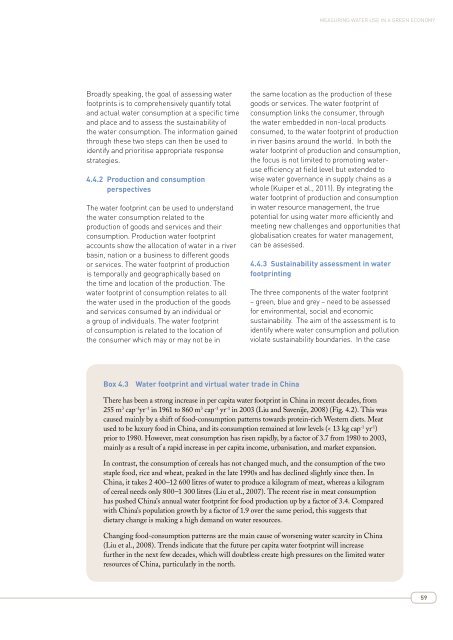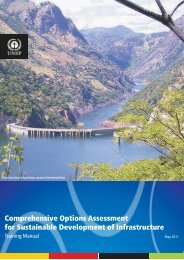MEASURING WATER USE IN A GREEN ECONOMY - UNEP
MEASURING WATER USE IN A GREEN ECONOMY - UNEP
MEASURING WATER USE IN A GREEN ECONOMY - UNEP
Create successful ePaper yourself
Turn your PDF publications into a flip-book with our unique Google optimized e-Paper software.
Measuring water use in a green economy<br />
Broadly speaking, the goal of assessing water<br />
footprints is to comprehensively quantify total<br />
and actual water consumption at a specific time<br />
and place and to assess the sustainability of<br />
the water consumption. The information gained<br />
through these two steps can then be used to<br />
identify and prioritise appropriate response<br />
strategies.<br />
4.4.2 Production and consumption<br />
perspectives<br />
The water footprint can be used to understand<br />
the water consumption related to the<br />
production of goods and services and their<br />
consumption. Production water footprint<br />
accounts show the allocation of water in a river<br />
basin, nation or a business to different goods<br />
or services. The water footprint of production<br />
is temporally and geographically based on<br />
the time and location of the production. The<br />
water footprint of consumption relates to all<br />
the water used in the production of the goods<br />
and services consumed by an individual or<br />
a group of individuals. The water footprint<br />
of consumption is related to the location of<br />
the consumer which may or may not be in<br />
the same location as the production of these<br />
goods or services. The water footprint of<br />
consumption links the consumer, through<br />
the water embedded in non-local products<br />
consumed, to the water footprint of production<br />
in river basins around the world. In both the<br />
water footprint of production and consumption,<br />
the focus is not limited to promoting wateruse<br />
efficiency at field level but extended to<br />
wise water governance in supply chains as a<br />
whole (Kuiper et al., 2011). By integrating the<br />
water footprint of production and consumption<br />
in water resource management, the true<br />
potential for using water more efficiently and<br />
meeting new challenges and opportunities that<br />
globalisation creates for water management,<br />
can be assessed.<br />
4.4.3 Sustainability assessment in water<br />
footprinting<br />
The three components of the water footprint<br />
– green, blue and grey – need to be assessed<br />
for environmental, social and economic<br />
sustainability. The aim of the assessment is to<br />
identify where water consumption and pollution<br />
violate sustainability boundaries. In the case<br />
Box 4.3 Water footprint and virtual water trade in China<br />
There has been a strong increase in per capita water footprint in China in recent decades, from<br />
255 m 3 cap −1 yr −1 in 1961 to 860 m 3 cap −1 yr −1 in 2003 (Liu and Savenije, 2008) (Fig. 4.2). This was<br />
caused mainly by a shift of food-consumption patterns towards protein-rich Western diets. Meat<br />
used to be luxury food in China, and its consumption remained at low levels (< 13 kg cap -1 yr -1 )<br />
prior to 1980. However, meat consumption has risen rapidly, by a factor of 3.7 from 1980 to 2003,<br />
mainly as a result of a rapid increase in per capita income, urbanisation, and market expansion.<br />
In contrast, the consumption of cereals has not changed much, and the consumption of the two<br />
staple food, rice and wheat, peaked in the late 1990s and has declined slightly since then. In<br />
China, it takes 2 400–12 600 litres of water to produce a kilogram of meat, whereas a kilogram<br />
of cereal needs only 800–1 300 litres (Liu et al., 2007). The recent rise in meat consumption<br />
has pushed China's annual water footprint for food production up by a factor of 3.4. Compared<br />
with China's population growth by a factor of 1.9 over the same period, this suggests that<br />
dietary change is making a high demand on water resources.<br />
Changing food-consumption patterns are the main cause of worsening water scarcity in China<br />
(Liu et al., 2008). Trends indicate that the future per capita water footprint will increase<br />
further in the next few decades, which will doubtless create high pressures on the limited water<br />
resources of China, particularly in the north.<br />
59

















